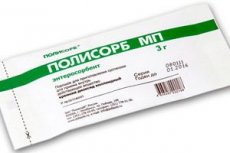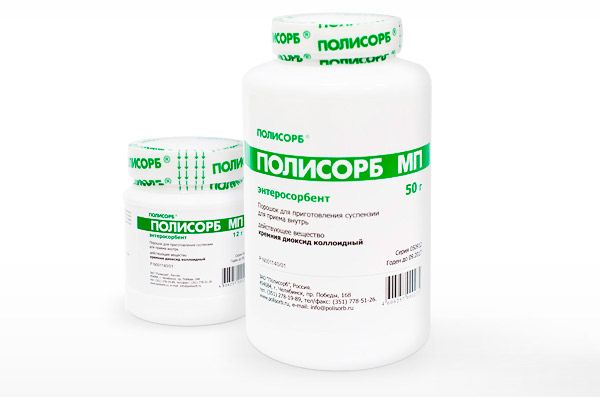Medical expert of the article
New publications
Preparations
Polysorb for psoriasis
Last reviewed: 03.07.2025

All iLive content is medically reviewed or fact checked to ensure as much factual accuracy as possible.
We have strict sourcing guidelines and only link to reputable media sites, academic research institutions and, whenever possible, medically peer reviewed studies. Note that the numbers in parentheses ([1], [2], etc.) are clickable links to these studies.
If you feel that any of our content is inaccurate, out-of-date, or otherwise questionable, please select it and press Ctrl + Enter.

Psoriasis (scaly lichen) is a chronic dermatological pathology of non-infectious genesis. It is characterized by the manifestation of typical for this disease, raised above the skin surface, flaky pink-red spots. The reasons for the occurrence of pathology have not yet been found. There are scientific hypotheses about the nature of genesis: autoimmune, genetic, endocrine, metabolic, disruption of normal neurohumoral reactions, due to stress. The occurrence of the first manifestations of scaly lichen occurs at the age of 15-30 years. There are many classifications of psoriasis developed by scientists.
Characteristic rashes are grouped by the localization of manifestations on the skin, by the degree of prevalence, by the severity of the general condition of the patient, by the characteristics of the rashes and their pathological properties. The provoking factors are considered to be: stressful conditions of the immune system, psychogenic cause of the pathology and heredity. The most common symptoms of psoriatic manifestations are considered to be: the appearance of non-cavity dense papules, prone to merging and covered with whitish or grayish easily separated scales. Psoriasis spots rise above the surface of the skin, causing itching and scratching. With minor trauma, "bloody dew" appears on the surface of the rash. The most typical distribution of localizations of psoriatic manifestations is the skin on the extensor surfaces of large joints, the scalp, areas of the body subject to friction.
The course of the systemic disease is wave-like with remissions, during which complete elimination of characteristic dermatological manifestations does not occur. It is impossible to completely cure psoriasis, but reducing and alleviating its manifestations is one of the goals of modern medicine. Given the mechanism of occurrence of psoriatic manifestations, a fairly large number of toxins accumulate in the body. Their removal plays an important role in reducing the manifestations of psoriasis.
 [ 1 ]
[ 1 ]
Indications polysorb for psoriasis
Treatment of psoriasis, which is a dermatose, is complicated by the lack of balance between the accumulation and removal of toxic substances from the body. The skin is a complex multifunctional system. Any toxic effect, both internal and external, can lead to pathological changes in it. The drug Polysorb is used to detoxify the body. The main indications for use of the drug:
- intoxication (acute or chronic) of both adult and child organisms, regardless of its cause;
- intestinal infections caused by various microorganisms;
- food poisoning;
- Intestinal dysbiosis;
- drug allergy;
- severe intoxication in purulent-septic conditions;
- acute chemical poisoning;
- chronic or acute sensitization (various types of allergic reactions);
- Complex therapy of hepatitis, pancreatic gland, renal failure (included in the treatment regimen).
Prevention of accumulation of hazardous chemical compounds in people living in areas with poor ecology.
 [ 2 ]
[ 2 ]
Release form
Active ingredient – silicon dioxide (SiO 2 ). Does not contain auxiliary ingredients. Only powder form of Polysorb is produced. Powder is snow-white with a slight bluish tint, odorless.
The drug is prepared into a suspension for oral administration. The drug is sold by the pharmacy network in plastic bottles of 12, 25, 50 g, as well as in 1 g or 3 g packages.
 [ 3 ]
[ 3 ]
Pharmacodynamics
Polysorb is an active enterosorbent with antacid properties. It has an absorbent effect. It adsorbs and evacuates harmful substances of exogenous and endogenous nature (allergens, endotoxins of bacterial and viral genesis, toxic metabolites of lipid and protein breakdown formed in the intestine). It facilitates the removal and transportation of toxic compounds, amines, and oligopeptides from the systemic bloodstream into the intestinal lumen. In the intestine, they bind to the sorbent and are evacuated from the body.
 [ 4 ]
[ 4 ]
Pharmacokinetics
Polysorb is not able to be absorbed or broken down by the gastrointestinal tract. It is excreted unchanged with feces. The sorption surface is 300 m2 / g. It acts instantly (in 2-4 minutes) when it enters the gastrointestinal tract.
Dosing and administration
The colloidal solution is prepared as follows: 1 tablespoon (1.2 g) of Polysorb for adults or 1 teaspoon (0.6 g) of the drug for children is added to a glass of cool boiled water. The solution must be thoroughly mixed until a homogeneous suspension is obtained. It is taken orally immediately after preparation. It is necessary to observe time intervals that take into account the diet or medication intake. Polysorb is used 60 minutes before or 1.5-2 hours after eating or taking medication.

Adults and children over 7 years of age are prescribed 12 g of Polysorb per day; children from 1 year to 7 years old - 150-200 mg/kg of the child's weight. The daily dose of the drug is divided into 3-4 doses. A single maximum permissible amount of the sorbent should not exceed half the daily dose.
The duration of the course of use of Polysorb for psoriasis is 14-21 days.
For the prevention and complex therapy of allergic sensitization, adults are prescribed 1-2 teaspoons three times a day before meals.
 [ 7 ]
[ 7 ]
Use polysorb for psoriasis during pregnancy
Pregnancy and lactation periods are not contraindications for taking Polysorb. The drug does not have a teratogenic property and does not harm the health of the mother. In the gestation period, long courses of enterosorbent are prohibited. Long-term use of Polysorb (more than two weeks) requires additional intake of vitamin complexes and calcium preparations, since this sorbent can slightly reduce their content in the bodies of the mother and the unborn child. For the correct selection of mineral and vitamin complexes, a specialist consultation is necessary. During the period of taking the drug, a tendency to constipation may occur. For preventive purposes, it is necessary to enrich the diet with foods rich in fiber.
Contraindications
- hypersensitivity to the active ingredient of the drug;
- children under 1 year of age;
- ulcers of the stomach and/or duodenum;
- intestinal erosions;
- intestinal atony.
 [ 5 ]
[ 5 ]
Side effects polysorb for psoriasis
Virtually none. Difficulty in bowel movements (constipation) and dyspeptic symptoms may occur. If allergic reactions occur, which is extremely rare, the drug should be discontinued. Long courses of Polysorb for psoriasis require the administration of mineral and vitamin complexes and calcium-containing drugs, since the enterosorbent slightly reduces their levels in the body's systemic bloodstream.
 [ 6 ]
[ 6 ]
Shelf life
The manufacturing date and expiration date of the drug are indicated on the factory cardboard packaging and plastic bottle. According to the instructions, the shelf life is 5 years. It is not recommended to use after the expiration date. The finished suspension can be stored for 48 hours in the refrigerator.
Reviews from doctors and patients
Polysorb is a natural drug without chemical preservatives and stabilizers. It is well tolerated by patients. It has a positive effect in the treatment of such dermatological diseases as psoriasis, atopic dermatitis, toxicoderma. A constant symptom accompanying these diseases is general endointoxication. Endotoxins lead to the body's insensitivity to many drugs.
Doctors who conducted research on the use of enterosorbents in the complex therapy of various systemic diseases noted that Polysorb is able to increase the body's susceptibility to drug treatment. The use of Polysorb in psoriasis as a detoxification method of therapy was successful in relieving dermatological manifestations of food and drug allergies and reducing psoriatic rashes.
Only complex treatment of dermatological diseases has a positive effect. According to medical research, treatment of psoriasis with short courses of fasting, use of Polysorb, antioxidants (vit. A and E), ointments for external use, UV radiation and lotions with celandine decoction gave positive dynamics. Half of the patients experienced almost complete recovery, and another quarter of those who took part in the experiment experienced a significant improvement in the condition of the skin.
The patients themselves note that with the complex treatment of psoriasis using specific drugs and the enterosorbent Polysorb, their skin itching, recurrence of rashes, and the area of lesions were significantly reduced.
Negative reviews about the use of enterosorbent Polysorb for psoriasis are left by people who, due to the characteristics of their body, find it difficult to take the drug. Patients find its consistency and taste unpleasant, or they have an intolerance to this product. In their reviews, they indicate that their negativity is associated only with subjective sensations.
Objectively, the majority of reviews, both from doctors and patients, indicate that the use of enterosorbent Polysorb as a component of complex treatment for psoriasis gives positive results. Consequently, it can be used in standard therapy for dermatological diseases of any genesis.
Attention!
To simplify the perception of information, this instruction for use of the drug "Polysorb for psoriasis" translated and presented in a special form on the basis of the official instructions for medical use of the drug. Before use read the annotation that came directly to medicines.
Description provided for informational purposes and is not a guide to self-healing. The need for this drug, the purpose of the treatment regimen, methods and dose of the drug is determined solely by the attending physician. Self-medication is dangerous for your health.

